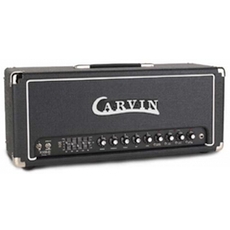 If you want a guitar amp that can cover a lot of territory with a price that won’t back you into a corner, it’s hard to beat the X-100B series from Carvin.
If you want a guitar amp that can cover a lot of territory with a price that won’t back you into a corner, it’s hard to beat the X-100B series from Carvin.
Throughout most of the 1980’s, it was pretty much impossible to read a guitar magazine without seeing large ads for Carvin guitars and amplifiers. Usually, the featured amplifier was Carvin’s X100B amp head. Artists as diverse as Frank Zappa, Steve Vai, and Craig Chaquico swore by the Carvin’s wide array of versatile sounds. Carvin discontinued the X100B line for years, but have recently reintroduced both the head and 2×12 combo version. The newer models are an attempt to capture the magic of the originals (with some slight modifications). Did Carvin succeed?
Specifications
I tested a X100B half stack complete with a 4×12 cabinet. Since Carvin now offers their amps in a variety of different coverings, I opted for the “White Bronco.” The amp head itself is a dual channel 100W amp that is switchable to 50 and 25 wtt settings. While it comes stock with four 6L6 tubes, the amp can take 6L6, EL34, or 5881 power tubes. Three AX7 tubes drive the preamp section. The amp features a shared EQ section with controls for bass, mid, treble, and presence along with a master reverb control. A master volume with switchable boost is included as is a five band graphic EQ that can be assigned to either the clean or lead channel. The 4×12 cabinet comes standard with four GT12 speakers, though you can upgrade to Celestion V30 speakers for a slight upgrade, which I chose to do.
Performance
The X-100B has been revered for years for its clean sound particularly, so I decided to focus on it first. And I’ll cut to the chase. Everything good you’ve heard about Carvin’s clean channel is true. It’s one of the purest, loudest, warmest clean sounds I’ve ever heard from a guitar amplifier. If you’re looking for a loud stage amp that can be used on either its own merits or with your effects pedals, look no further. The headroom is phenomenal and it maintains its basic sound at even painful volume levels. It responds well to the amp’s tone controls, though I didn’t really find a reason to employ the 5 band EQ. The bright switch added some usable tones as well though I would personally opt not to employ it, but I like a warmer sound.
Though the X-100B has always been celebrated more for its clean sound than its distortion, I think that anyone who gives the overdrive channel a fair hearing will be impressed. To my ears, it favors hard rock and blues sounds more than it does extreme metal, though you can definitely get some shred sounds here with the extra gain switch on the overdrive channel. Carvin labels this the series IV of the X-100B series, and so they’ve learned a few tricks since the 1980’s. This is definitely no one trick pony. Both the clean and overdrive sounds are first class.
When you look at the rear panel, you realize just how smart the Carvin engineers really are. In addition to the variable level effects loop, Carvin allows the X-100B to run at various power levels (to accommodate different arenas). They also have preset bias settings for different power amp tubes. Smart move, Carvin.
The Celestion-equipped 4×12 cabinet did an fine job in translating the X-100B‘s tones into sonic reality. Personally, I would like the option of different speakers (Electro Voice, for example), though the Vintage 30’s are a good match for the amp overall. The cabinet is very well constructed and can certainly be used for a variety of gigs with no worries.
Final Thoughts
Ultimately, I think this is one reissue that exceeds the original. The build quality is solid through and through, and the variety of sounds is very impressive. Even more amazing is the price. As usual, Carvin delivers a world class piece of gear with pawn shop prices. If you want a guitar amp that can cover a lot of territory with a price that won’t back you into a corner, it’s hard to beat the X-100B series from Carvin.
Name of Gear: Carvin X-100B
List Price: $1,395
Manufacturer Info: Carvin Corporation; carvin.com
Pros: Inexpensive; wide variety of sounds; versatile
Cons: None significant